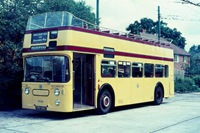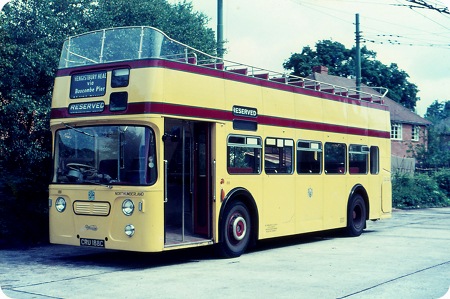Bournemouth Corporation - Daimler Fleetline - CRU 188C - 188
Bournemouth Corporation
1965
Daimler Fleetline
Weymann CO43/31F
As is with tradition on the south coast of England most open toppers were named, this bus was named
‘Northumbria’ which is a county in the North East of England. All the the other open toppers of the same
batch were also called after counties of England, I would be most upset if there wasn’t one called
‘Yorkshire’ as registration CRU 180C was called ‘Lancashire’. If you know, let me know, please leave a
comment.
It would appear that all this batch of Bournemouth open top Fleetlines except this one
were sold to London Transport for sightseeing duties I wonder why not this one where did it go? If you
know, let me know, please leave a comment.
"Yorkshire" was the next bus in the batch, CRU 181C.
Wasn’t
this livery with the green-edged maroon band much classier than the messy blue and brown daubings on
an overall yellow bus which replaced it?
But, have you noticed the absolutely miniscule fleet
number just above the offside headlamp? These always looked like they’d been done in Letraset and
were virtually unreadable at any distance; the previous shaded gold style might have been a bit Olde
Worlde but at least they were practical.
David Jones
05/07/11 - 06:40
The names chosen by Bournemouth Corporation for the convertible Fleetlines
were a curious bunch.
Bournemouth was in "Hampshire" (no 186) in those days of
course, and "Dorset" (no 185) was next door. "Warwickshire" (no 182) and
"Surrey" (no 189) may have been chosen in honour of the chassis- and body-builders
respectively. Many of the town’s summer visitors may have come from "Staffordshire" (no
183), "Cheshire" (no 184), and possibly "Lancashire" (no 180) and
"Yorkshire" (no 181), but "Northumberland" (no 188) and "Durham" (no
187) would seem to be pushing it at bit.
Michael Wadman
17/09/11 - 17:29
Mention has been made of the bright green lines outside the maroon bands on
BCT buses and trolleybuses.
I remember the older brown line, best described as "dark mud
brown" (that’s from memory) which had been used previously. I will try to establish when the
brown was changed to green, but am not hopeful - my best guess is around 1960 as I seem to remember
that the first MF2B trolleybuses had the brown lining when new, although it might have been earlier
when the wartime brown roofs were repainted yellow.
The open-toppers (in fact convertibles
with removable fibreglass roofs) were Bournemouth 180 to 189 CRU180C to CRU189C, and became London
DMO class as follows:
182 - DMO1 Stockwell Princess
183 - DMO2 Southern Queen
184
- DMO3 Britannia
185 - DMO4
186 - DMO5
187 - DMO6
189 - DMO7
I will
try to find out what happened to the ones that did not go to London.
Bill Nichols
21/11/11 - 09:22
I’m a 40 year old bus enthusiast lifelong resident to Bournemouth. Regards the
fate of 180, 181 and 188, obviously CRU180C was preserved in the collection of the Bournemouth
Passenger Transport Association 181 and 188 were withdrawn from service in Bournemouth circa spring
1979 and exported to Hong Kong (Source: Transbourne News, circular of BPTA, March 1986)
Obviously I have no idea whether 181 and 188 still exist I somehow doubt it, sadly!
Patrick O’Connor
11/12/11 - 07:05
Just to confirm that 181 and 188 no longer exist. According to PSV Circle
fleet history on Hong Kong operators, they entered service with Citybus Ltd in 1979; they were among
the very first vehicles acquired by Citybus, along with similar, but closed top ex Bournemouth
Fleetlines 190-3. By 1984, all six were in use as open toppers on tourist work. They were all
withdrawn and scrapped in 1986 (181/8/90/2/3) or 1987 (191).
Of those that went to London, 184
subsequently operated for many years for Guide Friday, mainly in Stratford on Avon. Does anyone know
if this survives in preservation?
Bob Gell
11/12/11 - 16:06
I have a feeling, Bob, that 184 went to Ensign Bus when they took over Guide Friday and is in store with them. That was the position a few months ago, anyway.
Chris Hebbron
23/02/12 - 12:41
The similarities to the Alexander bodied Fleetlines and Atlanteans we had at Northern General are remarkable, the front panel and windscreen would appear to be to be identical, so who copied who, or was one built under licence to the other?
Ronnie Hoye
23/02/12 - 14:00
Both Newcastle and Leeds had batches of identical bodies on Atlantean chassis. However the Newcastle ones did not have engine bustles and neither operators bought open top versions! I think it may have been Newcastle who were the first customers for this design as it was very similar to their Alexander bodied examples.
Chris Hough
24/02/12 - 07:08
Chris. Newcastle did have two open top Atlanteans, but they were the result of accident damage, both had been involved in arguments with bridges and unsurprisingly in both cases the bridge won. One of them went to Percy Main depot and was used on a Sea Front service operated by Northern on behalf of what was by that time the Tyne and Wear PTE, I think the other vehicle went south of the river and ran from South Shields to Sunderland. I seem to remember that in for the Queens silver Jubilee in 1977 one, or possible both of them were painted silver and had either the Royal Coat of Arms or a Crown on them.
Ronnie Hoye
25/02/12 - 07:25
The answer to "who copied who" is that Weymann optionally put the Alexander front end on to their standard body. Roe did something similar with windscreens but not the dash panel (see www.sct61.org.uk/gy57 ). But whether anyone paid Alexander for the privilege I wouldn’t know.
Peter Williamson
25/02/12 - 08:56
…..but it’s always been the case. East Lancs had their R type clone, but the earliest Alexanders were Leyland (Ribble) and Weymann (Glasgow - and Liverpool?) bodies built under licence. The Leyland Royal Tiger Alexander coach had more than awhiff of the Leyland as well.
David Oldfield
26/04/12 - 06:22
Four of this batch of Fleetlines certainly survived until 2011 - and hopefully
still do. 180 and fixed top 197 ex-B’mth Museum are now at the West of England Transport Museum, 187
is in private preservation nr. Southampton and 184 is with Ensign bus. The detachable roofs actually
combined the same amount of metal and glass-fibre as the permanent version - only 180 still has one.
The first MCW bodies to this style for Bournemouth were built on Atlantean chassis in 1964
(170 survives), the last on similar chassis in 1966 (none remain). Very similar MCW Alexander
lookalike bodies were delivered to Newcastle, Leeds and BOAC.
It was the inability of MCW to
build a further Bournemouth batch in 1968 that led to the genuine Alexander product finally arriving
in 1969. Happily the resultant delay allowed the trolleybuses several months stay of execution! The
relationship with Alexander then continued for over one hundred buses until 1990!
The lining
issue is simpler than it seems, a dark olive green was used between yellow and maroon from the first
trams until 1962 when it was replaced by lighter shade ‘Buckingham’ green. The first vehicles
so painted were the last nine Sunbeam trolleybuses. Future repaints used this colour green although
the old scheme could be seen until 1969 - lastly on trolleybus No.280.
The description of
muddybrown arises because the varnish used in those days to finish off the brush applied paintwork
would tend to yellow badly, combining with the olive green to become chocolate in colour - the
maroon discolouring to dark chocolate and the yellow oddly brightening with age! The lighter green
seemed to escape this process.
mf2b
17/07/13 - 07:00
I can clearly recollect a lengthy article, complete with photographs, in the
Bournemouth Evening Echo when these buses were introduced. It mentioned the novel concept of the
detachable roofs and the fact that the buses would be in the general-use fleet during the winter
months. I wish I still had the clipping!
It no doubt survives in the ‘Echo’ archives.
The general travelling public would have been probably unaware that they were travelling on a
‘convertible’ in the winter, but the names were a giveaway as the rest of the fleet did not
carry any.
Grahame Arnold
04/08/13 - 14:56
I took a few shots on the 29-03-1975 to record the passing of the traditional Bournemouth livery with the 2 red/green bands. Already by this time the rot was setting in, with adverts on the exteriors and the traditional Bournemouth large yellow bus stop signs being replaced with ‘standard’ ones. However, note that the driver is still smartly turned-out, even on a Sunday! AEL177B was one of the 1964 batch from Leyland with Alexander bodywork. They were comfortable buses, but noisier than the ‘CRU’ Fleetlines which followed in 1965.
Grahame Arnold
28/03/15 - 14:33
I know the messages have gone quiet on this. But just on the off-chance that someone reads this that knows the current owners. I’d like to speak to them. This summer these attractive and well designed, comfortable vehicles are/would have been 50 years old. CRU 180C was delivered new on 29/6/65 and 188 on 3/8/65. It would be great if someone knew if one was still roadworthy as I’d like to have a ride on it again?
Geoff Clarke
06/05/15 - 07:17
Geoff, 3 of these survive for sure they are 180, 187 and my 184. E-mail me through this site I can explain further.
Nick Jackson
06/07/15 - 06:36
Buses Magazine September 1983 Issue Page 410
DMO 2 and DMO 5 (CRU
183/6C) exported to California by Ensignbus
David Rawsthorn
20/03/17 - 13:55
As an update, my Bear Cross Bus Company now owns 187 as well as 184. 187 now
has a current MOT and it’s due to be repainted at the end of April. All being well it will make an
appearance at the Bournemouth Bus Rally in June. Unfortunately it won’t be fully restored though.
On the subject of painting, could "mf2b" please advise me what shade the
crimson/maroon band should be? I have two thoughts on the subject but can’t decide what the
post-1962 lighter shade should be and have nothing to compare against. Thanks.
Nick Jackson
21/03/17 - 06:16
Tim Salter had made quite a lot of progress recently but it’s been a mammoth task to restore it. I believe it might see some new paint this summer but don’t quote me on that!
Nick Jackson
21/03/17 - 08:43
Nick
Martyn Hearson at Reliance Bus Works has a history of painting
Bournemouth vehicles both for himself and Daniel Shears - he may know.
Roger Burdett
 Vehicle reminder shot for this posting
Vehicle reminder shot for this posting
18/04/17 - 07:40
I know Martyn and his excellent standard of workmanship. Tim Salter will be painting FEL216 himself, as he retires this summer and will have more time for the project.
Nick Jackson
Quick links to the - Comments Page - Contact Page - Home Page
Please leave a comment
Please Note if you want to send a photograph with your comment please use the Contact Page by clicking here or send as an attachment via email.

